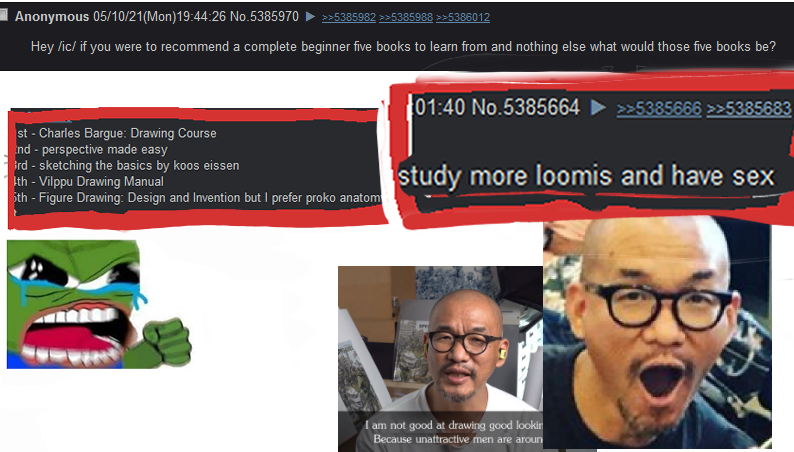
These are the best resources I’ve ever seen on how to study drawing. I’ve seen too many bad tutorials / books / courses and I hope I can help you avoid wasting time on those too. I suggest you watch everything, but how you study will depend on your goals, so only do the exercises you think are most important for you. Studying art mostly comes down to studying reference, so you can take any of these exercises and modify them for your own goals. If one guy teaches you how to draw from life, remember that you can just take the same method and use it to copy master artwork, and vice versa.
Remember that if you study, you WILL improve.
David Finch Roadmap: (Beginners should do this)
https://davidfinchart.com/where-to-start-and-where-to-go-from-there-a-roadmap-to-professional-quality-art/
(basic guide for construction and anatomy)
David Finch Study Streams: (the most highly recommended resource here)
Frank Frazetta: https://youtu.be/ZqJ2h4Jw5nU
Claire Wendling: https://youtu.be/7ukExmlSRWU
Simon Bisley: https://youtu.be/Z2CZKX089w0
Travis Charest: https://youtu.be/ko7H8FGwks8
Carlos Pacheco: https://youtu.be/jFkqUtJ4mRM
Kevin Nowlan: https://youtu.be/ni30Hp72aeY
Joe Quesada: https://youtu.be/atXd2HbHYO8
(Making master copies and drawing from memory)
Feng Zhu sketch studies:
Sketching 101: https://youtu.be/22XYoenU-0c
Just Draw!: https://youtu.be/WLqWX7onVmU
(importance of drawing from observation regularly)
Krenz Cushart: (turn on subtitles)
https://youtu.be/kbKqIJcIUCw
https://youtu.be/dgjx6y6B_G8
(importance of accuracy and master copies)
Naoki Saito
How to copy art: https://youtu.be/B5QetP4aa8w
Fastest way to improve: https://youtu.be/8jsZGeaWkhE
This /asg/ guide is really good:
https://drive.google.com/file/d/1cK9q7oeFRE58MVaSgUql662iGqCXC8Ah/view
(importance of memory drawing)
KJG memory drawing:
https://youtu.be/yx6dbybn-rk
https://youtu.be/WKbQ4TPMkFc
(memory drawing and rotating objects from imagination)
Dave Rapoza on applying studies from memory:
https://www.youtube.com/watch?v=m4tttsdhn8o&t=733s
(repetitively studying the same subject + memory drawing)
Animator Beast’s gesture drawing practice
https://youtu.be/yHJXLdCVD18
(gesture drawing with accuracy)
Kirk Shinmoto:
Master Copy: https://youtu.be/YVAtRojlCS8
Master Copy 2: https://youtu.be/cF2UtfFT7y8
Anatomy Books: https://youtu.be/9pAMqgJXcbw
(approaching master copies with construction)
Ethan Becker Dragging Art over Reference:
https://youtu.be/RXb-Y_kz2aU
(learning to draw on model)
Will Terrell on how to build a Visual Library:
https://youtu.be/pOK2sDLtu2Q
Christophe Younge Painting tutorials
https://www.youtube.com/@christopheyoungart/videos
Painting studies:
Color Studies: https://youtu.be/1d577v_XBKA
Quick color studies: https://youtu.be/CVGZf5EQQK4
Ahmed Aldoori: https://youtu.be/3YXTlF4hzaE
Noah Bradley: https://youtu.be/kQfF-P70V2Q
Japanese Croquis methods (quick sketch + proportions)
Minimaru:
https://youtu.be/avcygKfCoXQ
https://www.youtube.com/playlist?list=PLMzSsN13py1hIz1Q-s49LWF-IkKna9Swv
Hide Channel:
https://youtu.be/v-Ej9EIlfoc
https://youtu.be/xcb4ghm__Zc
https://youtu.be/ZHJWjclAVnI
https://youtu.be/MUtH6v8k0BY
(turn on cc)
Misc
(Everything below this is just miscellaneous stuff that’s interesting. Not all of it is necessarily about how to make studies.)
Zapata Perspective: https://youtu.be/_9tcy2436iM
Jeff Watts on the time it takes to learn drawing: https://youtu.be/KX0MrnzBJ8M
PSG Art tutorial: http://androidarts.com/art_tut.htm
Beast Animator’s streams: https://www.youtube.com/playlist?list=PLcZnl-xtyEqalCVkvhWr3FH8qp41QBJqF
Natalie Nourigat
Gesture drawing: https://youtu.be/Fa9CLiGhWr4
Comics Advice:
https://homeiswheretheinternetis.blogspot.com/2015/04/advice-for-aspiring-comics-artists-14-18.html
Feature animation storyboarding advice:
https://homeiswheretheinternetis.blogspot.com/2017/09/animation.html
Joe Kubert mail order dvd course:
Pencilling: https://youtu.be/Zt_j70hzSrE
Inking: https://youtu.be/sDc1b5qNSNI
YenYen Animation lectures:
https://youtu.be/JUO3wrCnOFk
https://youtu.be/O84C_11MUXM
Figure Drawing apps:
Gesture Drawing!: https://www.artstation.com/marketplace/p/k1Vq/gesturedrawing
Quickposes: https://quickposes.com/en/desktop-app
Glenn Vilppu:
https://tv.creativetalentnetwork.com/axChannel.php?id=58
https://www.bilibili.com/video/BV145411A7CV/
Craig Mullins Sijun Posts
https://archive.org/details/CraigMullinsSijunPosts
Recommended Books:

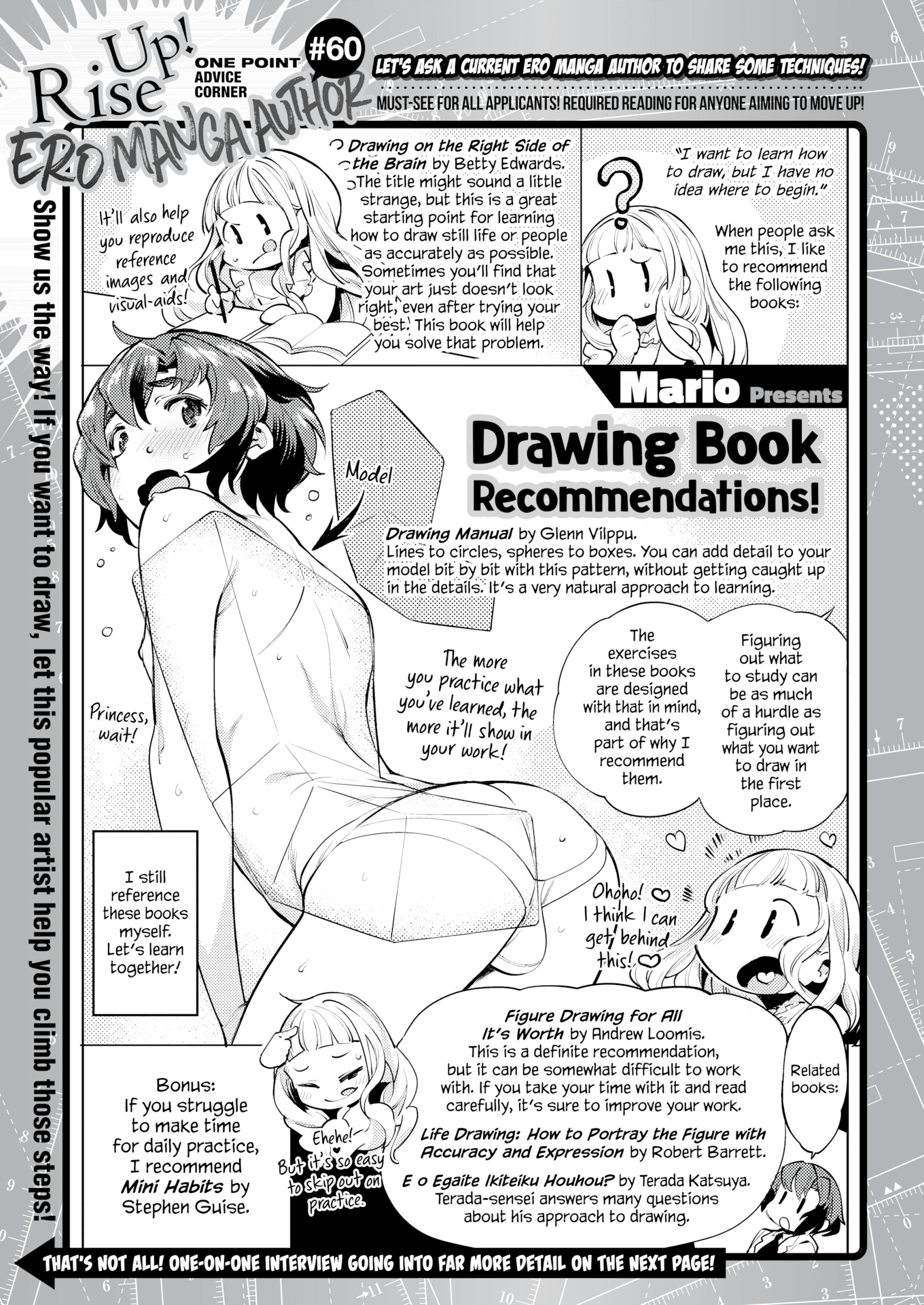
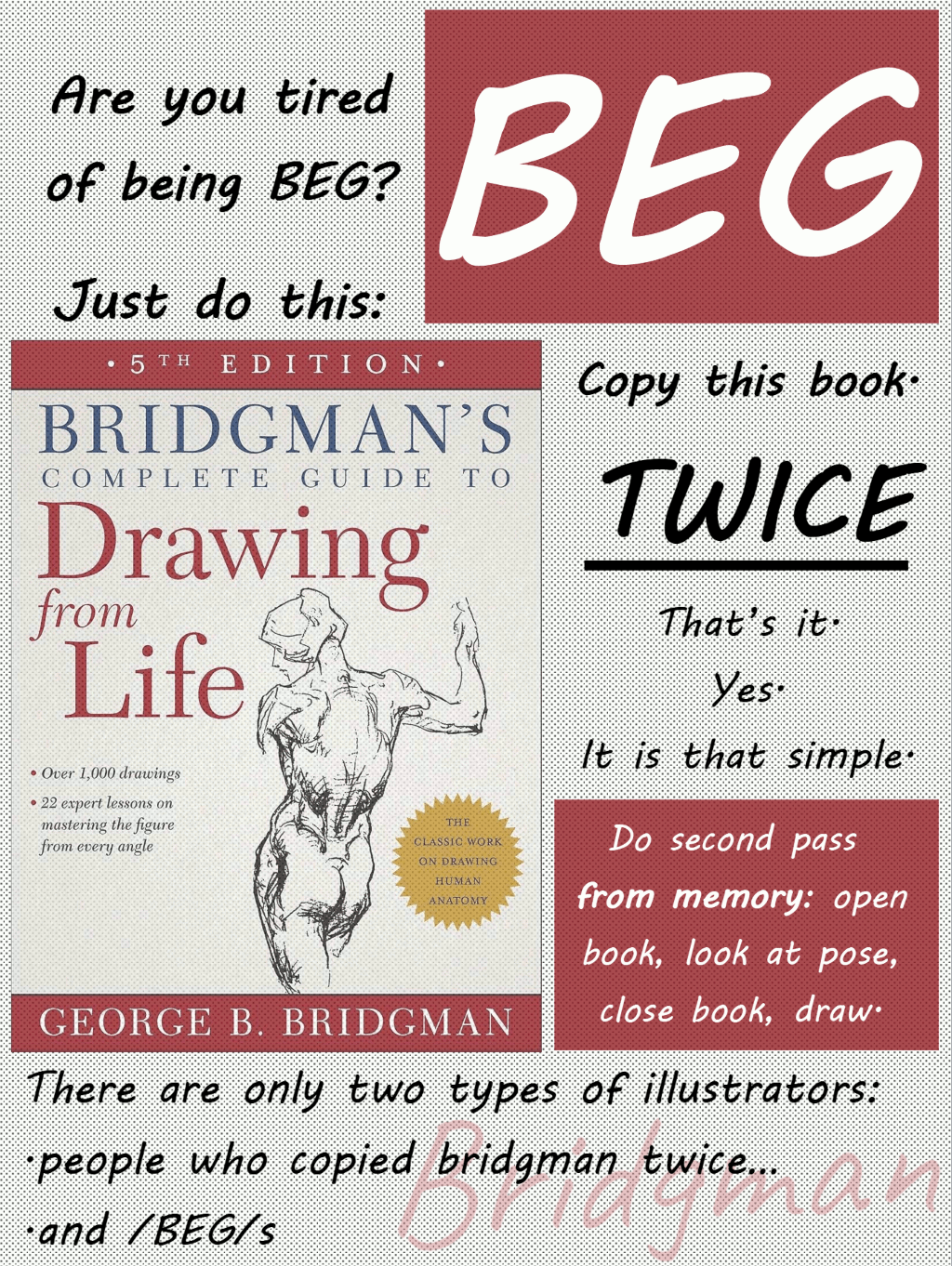
A redliner’s advice
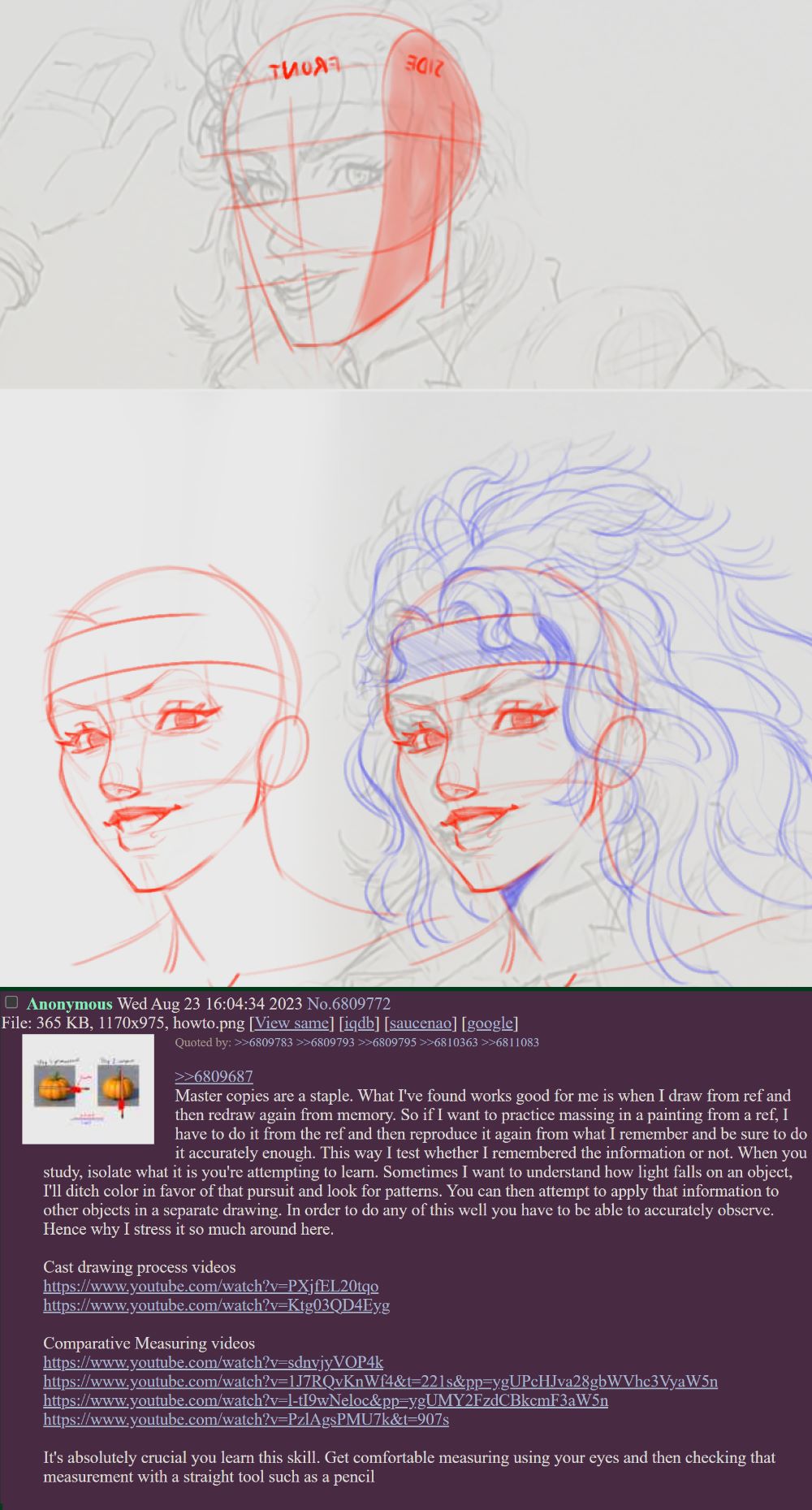
For the links in the above image, here’s the thread: https://warosu.org/ic/thread/6809247#p6809772
/Mecha/ general op’s advice
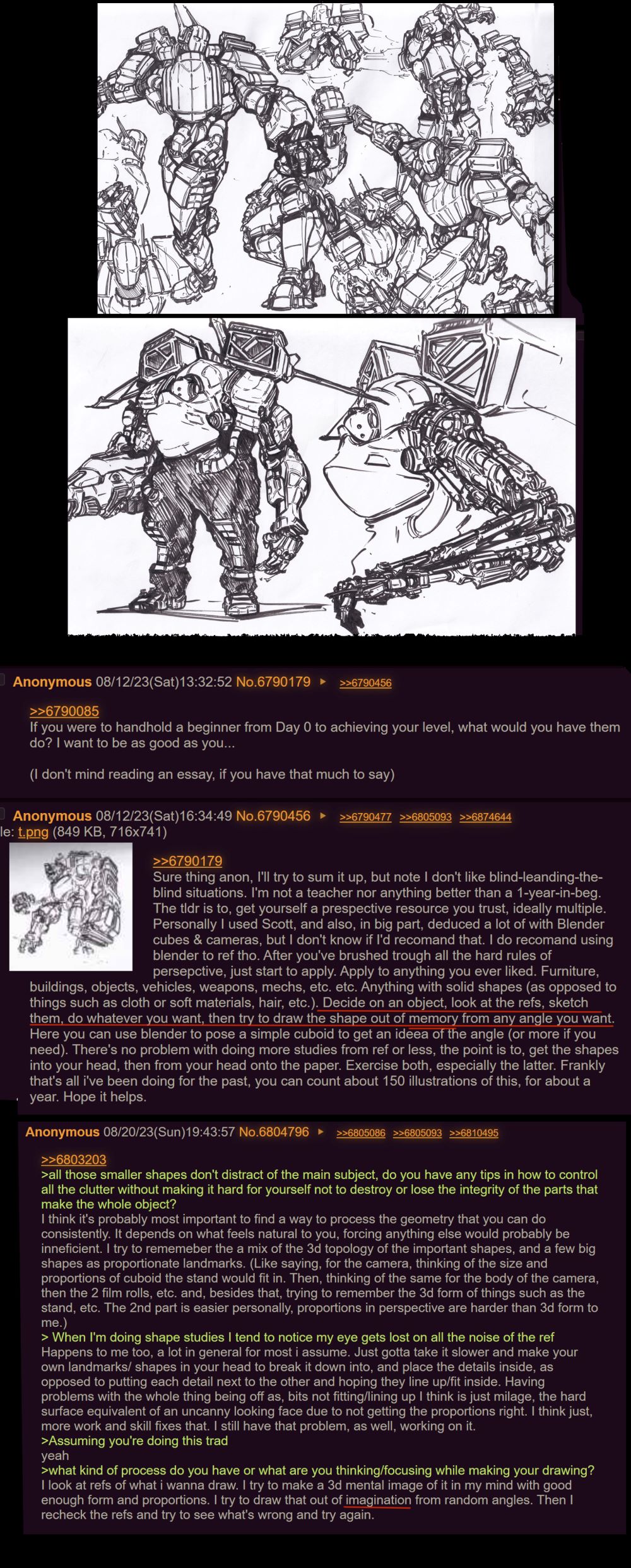
Tableguy’s advice
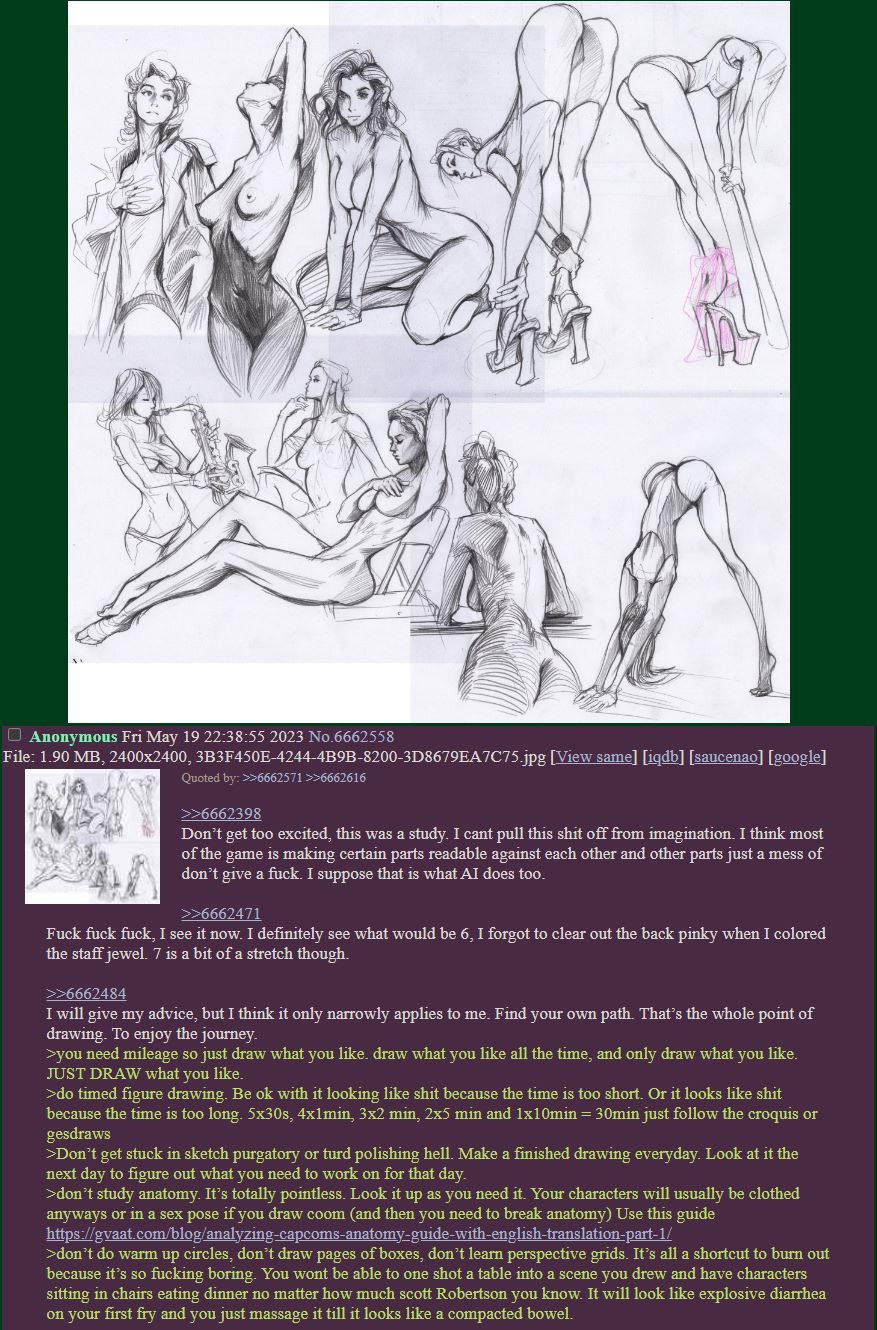
Velleity Art’s advice
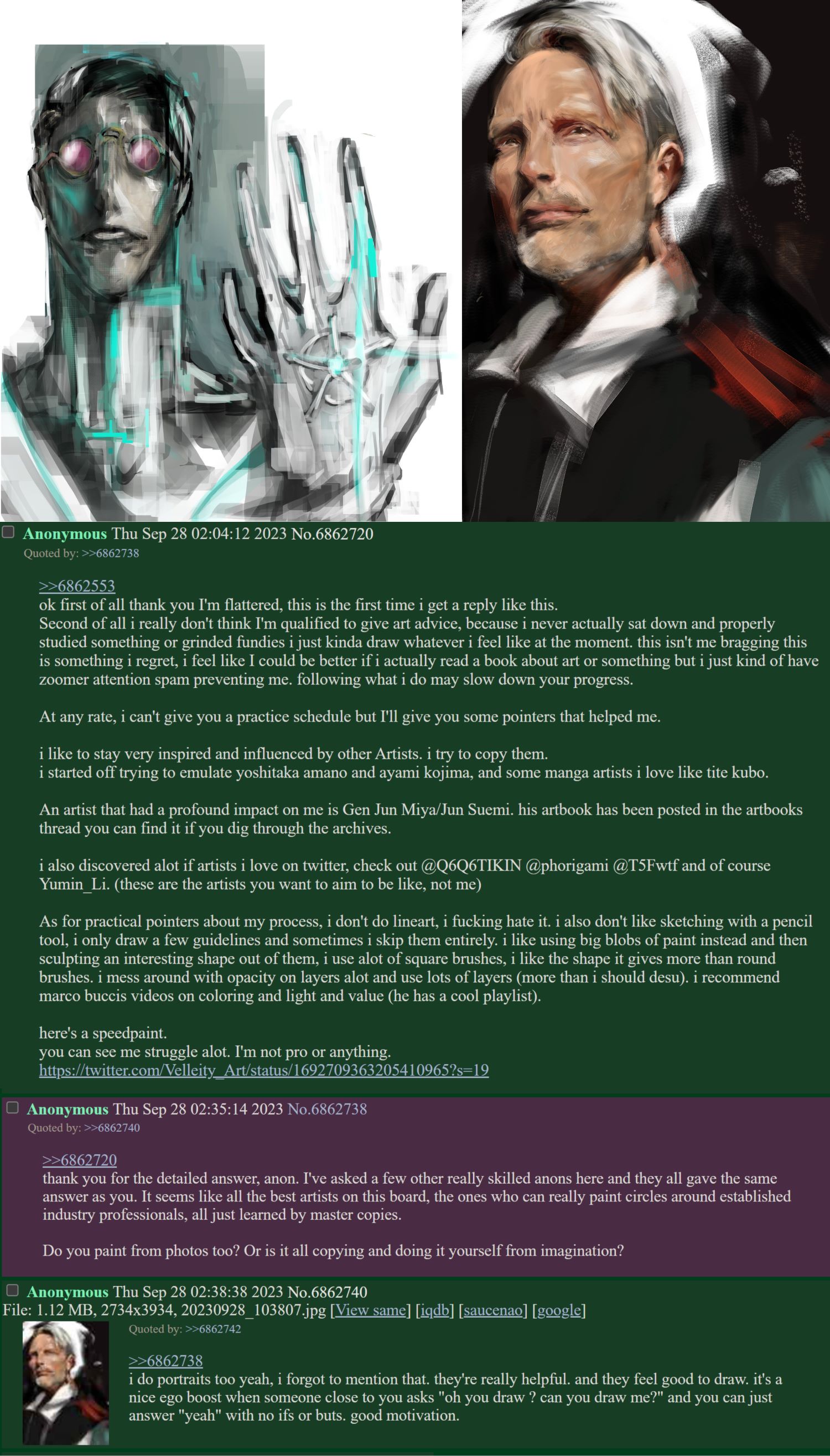
Slowpoke’s advice

Note: Slowpoke has done over 2000 master copies!
If you need to download the images here, get the extension “Save as PNG” because for some reason HackMD only lets you save XML files
Step 1: Get some momentum on the basics
Get Michael Hampton’s book. Learn what gesture and form is. Learn your basic anatomy. Take 2-3 months to just do this, applying Michael Hampton’s theories to photo references and master copies. It’s also a good idea to directly copy the images in Hampton’s book. Just take some time to understand what he’s talking about. Don’t get stuck on this step, because your “real” improvement will begin in the next stage. Even if you feel like you don’t fully understand Hampton yet, move on anyways.
I also recommend reading Steve Huston’s book: “Figure drawing for Artists”. Robert Beverly Hale’s “Drawing lessons from the great masters” is also good, but it’s difficult to apply (as it’s mostly text) and he himself has some very extreme takes on things, like memorizing the entire skeleton (which isn’t necessary). John Buscema’s “How to draw comics the marvel way” is also great.
Maximum time: 3 months
Step 2: Master copies
This is where the bulk of your learning takes place. At this stage, you’re going to get your favorite artist’s work and copy them every single day, for hours. Just paper and pencil is fine, and just copy the linework, not the shading yet. The reason I wanted you to speedrun Michael Hampton’s work is because I want you to do master copies asap. Master copies are HOW you truly understand the fundamentals. You will only finally understand the principles of form and gesture HERE by doing master copies. If you spend too much time on Hampton, without applying them to master copies, you will plateau and not see much progress.
Watch the David Finch study streams at the top of this page. That is how I want you to do these master copies. Copy the reference, then put away the reference and your drawing, and redraw it from memory. This is how you translate your copies into imagination work.
BE ACCURATE when you do master copies. Copy it point by point, line by line, if you have to. The effort you put into copying something accurately directly translates to how much you improve. If you are working digitally, you could even take the pain of overlaying your drawing over the reference image, to see how accurate you were.
Focus on figure drawing and anatomy for the bulk of this time. Learning to draw characters is most difficult. Begin an extensive manga / comic / artbook collection so you have a lot of art that you can study. When you get comfortable with this, begin copying line weight, hatching techniques, background elements, etc. Take some of these copies to a finish, and do some copies where you only capture the basic shapes. It’s up to you.
To give you an idea of how much work it takes to learn to draw, Rad Sechrist said that you have to do master copies for 4 hours a day, for 4 years straight, in order to become a professional artist. That number seems about right in my experience. Fortunately, master copies are a very pleasant and relaxing way to practice. Indulge in your favorite type of art, don’t copy Michelangelo just because Vilppu told you to. Copy what you want.
If at this stage you feel like you want to review Hampton a bit, that’s fine. Just make sure you keep doing your master copies the bulk of the time.
You should be doing master copies instead of copying photo reference because it’s a lot easier to copy art. You’ll learn more per minute of study, and you’ll develop a good sense for design.
Feel free to spend 6 months to a year doing just this, before moving onto Step 3. On the other hand, you could start Step 3 right now, along with your master copies.
Step 3: Imagination work + Visual Libary
Start making finished art. Draw from imagination and apply what you learned from Master copies. Find references for objects that you want to include in your finished work. This is how you build your visual library: by finding references and incorporating them into your art.
Start a portfolio of finished work. This is your gateway to becoming a professional artist. If you don’t have a body of work, you have a lot to catch up on if you want to begin a career.
KEEP DOING YOUR MASTER COPIES. Don’t stop! Begin each day with 1-2 hours of master copies. You don’t have to keep reviewing your Michael Hampton, but if you need to review your anatomy, please do.
At some point, learn perspective. You need it for backgrounds and hard objects. It’s also a good idea to start doing some life drawing, but it’s literally impossible to draw figures from life / photos properly until you have a strong foundation of master copies under your belt, so focus on studying figures through master copies at first.
When you feel like you have a good foundation of master copies (1-3 years experience of master copies), feel free to study from photo references as well. However, most artists will continue to do master copies for the rest of their life, and they end up doing a combination of both master copies and life drawing.
Start learning shading and color too. Master copies are the best way to do this.
You can begin “step 3” as soon as you wish, even right from Day 1. I just divided this roadmap into 3 steps for clarity.
Conclusion
The 3 steps above are an arbitrary division. Begin your master copies alongside your fundamentals study, and begin making finished art alongside your master copies. There’s no real division, because making master copies IS fundamentals study, and making finished art IS a way of studying your favorite artists. They’re all interconnected.
If I had to weigh master copies against drawing from imagination, I’d say that master copies are definitely more important. This is because we humans only grow through “input”. We become capable of doing more than we previously could by taking in knowledge from the world and encoding them into our brains. If all you ever do is draw from imagination, you’re leaving it up to random chance that you’ll improve.
You don’t HAVE to copy something exactly to improve, by the way. Kim Jung Gi’s recommended method of study is to observe something in the real world, then to draw it from various angles from memory. That is a form of “input”. Boichi said in a video that he didn’t have the time to set aside to practice drawing while creating a serialized manga, and that the way he still improved was by having photo references up while drawing his own manga pages. He talked about buying the Vagabond manga ebook and having it up on a second monitor, and he’d look up and incorporate hatching techniques from Vagabond into Dr. Stone. That too is another form of “input”.
If there is a specfic art job you’re aiming for, like concept art or comic books, make sure to do your research. This guide is literally just the bare minimum roadmap you need to make progress fairly rapidly.
Guides:
https://learnjapanese.moe/routine/
https://animecards.site/learningjapanese/
https://www.reddit.com/r/visualnovels/wiki/gambsguide/
https://rentry.org/gitgud
https://www.antimoon.com/how/howtolearn.htm
Success Stories:
https://www.reddit.com/r/LearnJapanese/comments/l51r3d/my_500_day_journey_to_a_160180_n1_score_w_tips/
https://www.reddit.com/r/LearnJapanese/comments/sedr0m/how_i_got_180180_on_n1_in_85_months/
(Time to move to Japan to work as an animator/mangaka :D)
(The Western Art Industry is filled with corrupt executives who ruin shows and are rotting the landscape of Western art. There’s no more hope for real creatives in America. Time to revolt against the system. Time to become Japanese.)